Accepted Scientific Name: Rebutia deminuta (F.A.C.Weber) Britton & Rose
Cactaceae (Britton & Rose) 4: 285. 1923 Britton & Rose
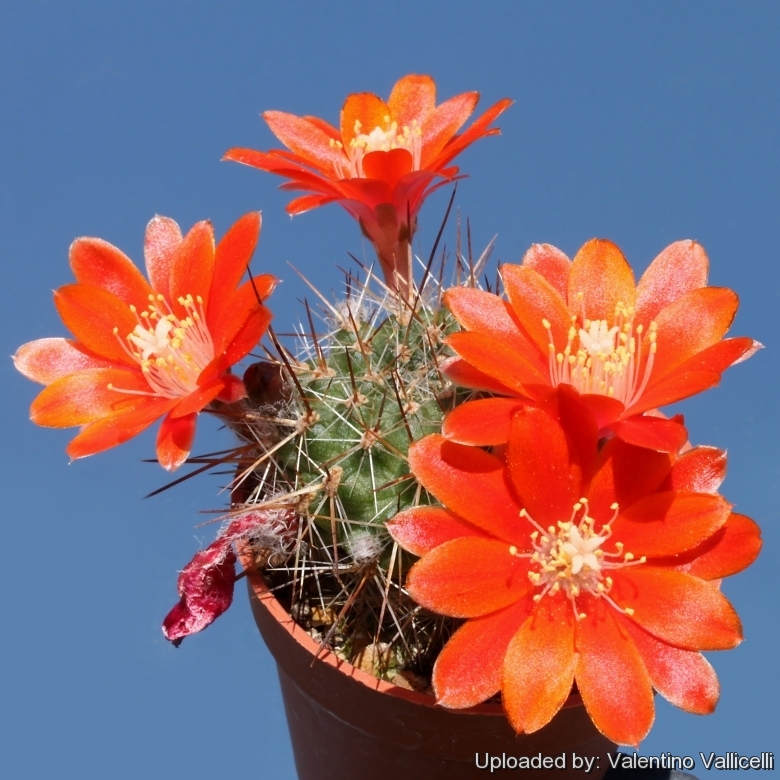
Rebutia robustispina Photo by: Valentino Vallicelli
WR 88 (Collector Walter Rausch) Tarija, Tarija, Bolivia. It has shaggy stiff brown spines.
Origin and Habitat: Tarija, Bolivia.
Altitude: 2200-3800 metres above sea level.
Habitat: Grassy / rocky slopes.
Synonyms:
See all synonyms of Rebutia deminuta
back
Accepted name in llifle Database:Rebutia deminuta (F.A.C.Weber) Britton & RoseCactaceae (Britton & Rose) 4: 285. 1923Synonymy: 50
back
Description: Rebutia robustispinaSN|4953]]SN|4975]] is one of the several forms of the very variable Rebutia deminutaSN|4975]]SN|4953]] which form a complex of related taxon. It is still unclear whether this variable complex is one or several species. There is so much variation that most authors choose to lump them together. Rebutia robustispinaSN|4953]]SN|4975]] distingushes from the standard Rebutia deminutaSN|4975]]SN|4953]] in that it has stronger shaggy stiff brown spines.
Habit: Solitary or branching around the base and forming small mounds up to 10 cm in diameter (or more) barely rising above ground level.
Stems: Globular to more or less cylindrical, sometimes tapering apically, dark shiny green, 5 to 6 cm high, up to 3,5 cm in diameter (but often more in cultivation).
Ribs: 10-14 not prominent, somewhat spiraled, more or less tuberculate. Tubercles conical 5 x 7-8 mm.
Areoles: Whitish grey 7-11 mm apart.
Spines: 10-12, brownish, rigid 4-20 mm long, acicular and stiff. becoming white with a rusty brown tip and eventually white finally almost transparent white.
Central spines: 1-4.
Radial spines: 7-14.
Flowers: Several, orange, growing in a ring from around the base of the stem. Funnel-shaped up to 3 cm long and in diameter. Pericarpel with 7-8 scales with a solid tube having scales with axillary hairs. Perianth disc-shaped; outer perianth-segments lanceolate, purple, 4 to 5 mm long; inner perianth-segments 15, red to orange, 5 to 18 mm long; pericarpel bristly, 6 mm in diameter with about 7-8 scales with axillary hairs; tube 1,5 cm long firm; styles pink stigma-lobes white; stamens with white filaments; anthers yellow.
Seeds: Strongly warty with a large hilum.
Subspecies, varieties, forms and cultivars of plants belonging to the Rebutia deminuta group
Bibliography: Major references and further lectures
1) Roger Spencer “Horticultural Flora of South-eastern Australia Volume 2, Flowering Plants: Dicotyledons. Part 1, the Identification of Garden and Cultivated Plants” UNSW Press, 1995
2) Edward Anderson “The Cactus family” Timber Press, Incorporated, 2001
3) James Cullen, Sabina G. Knees, H. Suzanne Cubey "The European Garden Flora Flowering Plants: A Manual for the Identification of Plants Cultivated in Europe, Both Out-of-Doors and Under Glass" Cambridge University Press, 11/Aug/2011
4) David R Hunt; Nigel P Taylor; Graham Charles; International Cactaceae Systematics Group. "The New Cactus Lexicon" dh books, 2006
5) N. L. Britton, J. N. Rose “The Cactaceae. Descriptions and Illustrations of Plants of the Cactus Family.” Volume 4, The Carnegie Institution of Washington, Washington 1923
6) Curt Backeberg “Die Cactaceae: Handbuch der Kakteenkunde” Gustav Fischer Verlag, Stuttgart New York 1982–1985
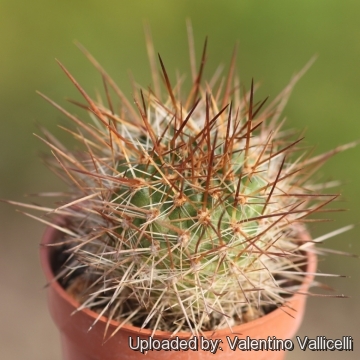 Rebutia robustispina Photo by: Valentino Vallicelli
Rebutia robustispina Photo by: Valentino Vallicelli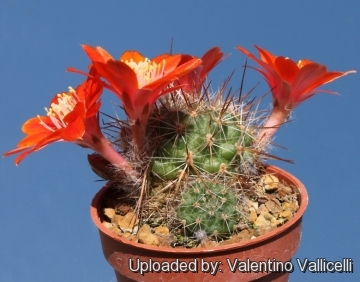 Rebutia robustispina Photo by: Valentino Vallicelli
Rebutia robustispina Photo by: Valentino Vallicelli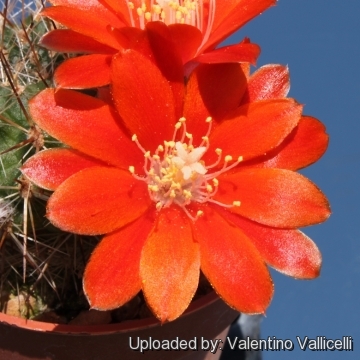 Rebutia robustispina Photo by: Valentino Vallicelli
Rebutia robustispina Photo by: Valentino Vallicelli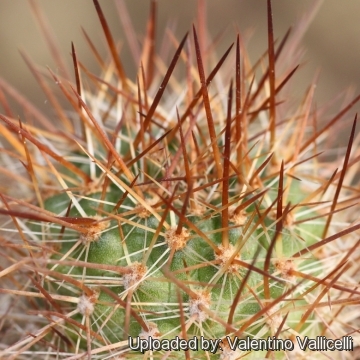 Rebutia robustispina Photo by: Valentino Vallicelli
Rebutia robustispina Photo by: Valentino VallicelliCultivation and Propagation: Rebutia robustispinaSN|4975]]SN|4975]] is a summer grower species that is easy to cultivate.
Growth rate: It is a relatively rapidly growing and easily flowering species that will make clumps given the best conditions.
Soils: It likes very porous standard cactus mix soil. Prefer a neutral or low pH compost, avoid substrata rich in limestone.
Repotting: It is better that they are repotted regularly. Repotting will increase the number and size of stems and will increase the number of flowers produced. Repot yearly until reaching about 100mm in size, then every two or three years will suffice. Repotting is best done at the end of winter but can be done at other times. Do not water for a couple of weeks after repotting to reduce risk of root rot via broken roots. Use pot with good drainage.
Watering: Needs moderate to copious waterings in summer, but do not overwater (Rot prone), keep dry in winter at a minimum temperature of 0°C.
Fertilization: Feed with a high potassium fertilizer in summer.
Hardiness: Reputedly resistant to frost if kept on the dry side prior to, and during, cold weather (hardy to -4 C ° C, or less for short periods).
Exposition: The plant tolerates bright situations but enjoys filtered sunlight or afternoon shade, inside it needs bright light, and some direct sun. Tends to bronze in strong light, which encourages flowering and heavy spine production, but is likely to suffer from sun scorch or stunted growth if over exposed to direct sunlight during the hottest part of the day in summer.
Uses: It is an excellent plant for container growing. It always looks good and stays small. It look fine in a cold greenhouse and frame or outdoor in a rockery.
Pests & diseases: It may be attractive to a variety of insects, but plants in good condition should be nearly pest-free, particularly if they are grown in a mineral potting-mix, with good exposure and ventilation. Nonetheless, there are several pests to watch for:
- Red spiders: Red spiders may be effectively rubbed up by watering the plants from above.
- Mealy bugs: Mealy bugs occasionally develop aerial into the new growth among the wool with disfiguring results, but the worst types develop underground on the roots and are invisible except by their effects.
- Scales: Scales are rarely a problem.
- Rot: This species is particularly easy and accommodating, seldom suffer of cryptogamic diseases. Rot it is only a minor problem with rebutias if the plants are watered and “aired” correctly. If they are not, fungicides won't help all that much.
Propagation: Division, direct sow after last frost. Seeds germinate in 7-14 days at 21-27° C in spring, remove gradually the glass cover as soon the plants will be well rooted (ca 1-2 weeks) and keep ventilated, no full sun for young plants! Seed Collecting: Permit fruit to ripen. Fruit must be significantly overripe before harvesting seed; clean and dry seeds. To make a cutting twist off a branch and permit it to dry out a couple of weeks, lay it on the soil and insert the stem end partially into the soil. Try to keep the cutting somewhat upright so that the roots are able to grow downward.















